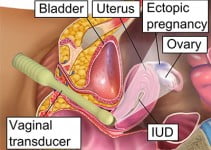 If you are a first-time mom, then you may be worried about the labor and delivery portion of your pregnancy.
If you are a first-time mom, then you may be worried about the labor and delivery portion of your pregnancy.
There are horror stories all over the internet that you’ve probably read that may make you a bit nervous and anxious about the birth.
However, don’t worry. Your body was created to undergo childbirth and with proper medical care, you can have an easy labor and delivery.
Table of Contents:
- Stages of Labor
- First Stage of Labor
- Second Stage of Labor
- Third Stage of Labor
- Signs of Approaching Labor
- Tips for an easier delivery
- Some Reasons Why Labor Might Be Slower
- Ways to Speed up Labor without Doctor Intervention
Stages of Labor
Women undergo three different stages of labor. In simple terms, the first stage is the time period between the onset of labor until the cervix is completely dilated.
The second stage is then defined as the period of time between the complete dilation of the cervix and the delivery of the baby. Finally, the third stage of delivery is the delivery of the placenta.
Each stage of labor has a normal time frame associated with it. If the stages of your labor exceed these normal time frames, then you may be a candidate for a cesarean section.
First Stage of Labor
The first stage of labor is the longest and is the stage that most women fear. Thinking about having hours upon hours of contractions often send anxiety through women. The first stage of labor can be divided into three phases.
The early labor phase is the onset of labor until the cervix is dilated to 3 cm. Most women experience this stage of labor while at home and before they even really know that they are in labor.
Once you have reached 35 or 36 weeks, your OB/GYN will begin to do weekly cervix checks to ensure that you are progressing appropriately.
Most women tend to be a few centimetres dilated before they ever reach the hospital, which is a great sign.
This means that if you are nervous about the first stage of labor, then you don’t need to be. You may be one of the lucky majority who goes through the first phase of the first stage of labor while at home relaxing.
If you haven’t dilated at all by the time it is time to deliver, then you may be induced. This means that you will be given medication to induce your labor. Whether you are induced or not, early labor may last around 8 to 12 hours.
The second phase of the first stage of labor is the active labor phase. This is the phase in which your cervix will dilate to approximately 7 cm.
This stage can last around 3 to 5 hours in total and is the time that you should head to the hospital if you were trying to labor some at home.
During the active stage of labor, you can expect contractions approximately every 3 to 5 minutes that last around one minute long. The contractions may get more intense as your cervix dilates more.
The transition phase of the first stage of labor is often the most tiring for the laboring mother. This is often the most challenging phase of labor, but also the shortest.
Once you enter the transition phase, you can expect contractions every 30 seconds to 2 minutes, and they could last for up to 90 seconds each. Fortunately, though, this phase of labor should only last 30 minutes to 2 hours.
Second Stage of Labor
The second stage of labor is the stage in which you will deliver your baby. Once you have gone through all three phases of the first stage of labor, you will be ready to push.
By this point, your nurses and OB/GYN may have already walked you through some practice pushes during your transition phase. The pushing stage of labor may take anywhere from a few minutes for seasoned moms to a few hours.
During this stage of labor, your nurses and OB/GYN will monitor you and the baby closely to ensure that you both are tolerating labor well and that you aren’t growing too tired.
If you are a new mom and grow tired during pushing, then you may be given a slight break in pushing or may need to start thinking about a c-section.
Third Stage of Labor
Once your baby has been born, then you reach the third stage of labor. This stage occurs when the placenta is delivered. Most women deliver the placenta within a few minutes of delivering their baby.
However, this stage of labor may take up to 30 minutes to complete. Once the placenta is delivered, then your OB/GYN will look for any lacerations or tears that occurred during labor and stitch any tears while you enjoy your brand new baby.
Signs of Approaching Labor
Here are seven tell-tale signs that your baby is on its way very soon.
1. Baby Dropping
For labor and delivery to occur, your baby needs to drop into your birth canal. This can occur up to a month before your labor actually begins if you are a first time mom.
However, if you feel your baby drop into the birth canal, then you know that it will be only a few short weeks before you deliver.
If you have already delivered a child, then you may experience your baby dropping only a few days before labor will start.
Your baby dropping can be an uncomfortable feeling, but it is a great sign. Many women may feel pressure and some pain in their pelvis when the baby drops, especially when they walk.
This feeling comes from your baby’s head pressing on your cervix. While this may feel uncomfortable, it means that your baby is in the right position for a safe delivery.
2. Increased Cramping and Pain
As your labor approaches, you may start to experience more cramping and pain. These cramps may be called Braxton Hicks Contractions, and are a way that your body prepares for labor.
These contractions are practice contractions and allow your muscles and joints to stretch and get ready for labor.
As you approach your due date, you may start to feel more and more of these Braxton Hicks Contractions.
But, if you notice that your practice contractions and pains are becoming more regular and closer together then call your doctor. This may indicate that your practice contractions have turned into real contractions.
3. Loose Joints
Some women reach the end of their pregnancy and realize that they have become a bit clumsier than usual.
While this may be because of the changes in their bodies and their big pregnancy bellies, it also may be a sign of approaching labor.
As you get closer and closer to your due date, your joints and ligaments will begin to get looser to prepare your pelvis for delivery.
4. Nesting
If you suddenly have the urge to clean your home from top to bottom and redo the entire nursery, then you may be approaching your delivery date.
Nesting is a primal instinct that makes you want to get everything ready for your baby. Not every woman feels this instinct, but if you do, then your house may get a deep cleaning right before you go into labor.
5. Mucus Plug
As your labor approaches, you may notice that you lose your mucus plug. This is a small amount of mucus that is at the end of your cervix and protests your uterus from bacteria and other infections.
Your mucus plug may come out all at once, or in smaller pieces. If you notice this loss, then don’t worry. It just means that you may start feeling stronger and more regular contractions within the next few days.
6. Stronger Contractions
The tell-tale sign of labor approach is that your contractions and pains begin to get stronger. At first, your Braxton Hicks Contractions will be soft and short.
As you get closer to your delivery date, you will begin to notice stronger contractions that may knock you off of your feet and take your breath away.
Stronger contractions are a good sign because it means that your uterus is getting ready for delivery.
Once again though, if your contractions become regular and are consistent, then head to the hospital because it might be time for your baby to come.
7. Water Breaks
If your water breaks, then you are definitely in labor and need to head to the hospital. Even if you are not full term yet, you should go to the doctor or the hospital the minute that your water breaks.
Once your water breaks, the baby needs to be checked on and your amniotic fluid level needs to be obtained. If you are full term, then your water breaking means that you will definitely be having your baby within the next day or two.
If you are pre-term then your doctor may try to stop your labor and then reevaluate your amniotic fluid level to ensure that your baby is safe and healthy.
If you are nervous about labor and delivery, then talk with your doctor. Every woman has a bit of anxiousness surrounding labor and delivery, but every woman’s body was created for this process.
A little nervousness is normal, but just remember that your body will deliver your child if you are nervous or excited.
If you experience any of these signs of approaching labor, then rest assured that your body is doing its thing to start labor.
These signs of approaching labor may occur as early as a month before your due date. You may experience some or all of these signs, or your body may have its own signs that tell you that labor is approaching.
Be aware of your body, and always ask your doctor about any signs or symptoms that seem out of the ordinary for you.
Most of all, be excited as you feel these approaching signs of labor. These signs mean that you will soon have your baby and start a new adventure with your family.
Tips for an easier delivery
Labor will be one of the toughest things you will have to go through. But although the process can be challenging, there are ways to put you at ease.
The steps to take to make childbirth a little easier to bear should start while you’re still pregnant. Here’s what you can do:
1. Make sure to put in time for physical activity
Research has proven that exercise during pregnancy leads to a shorter pushing phase during labor. As such, your labor will be shorter and less painful.
The best exercises for pregnant women are of the cardiovascular variety. So take your pick from biking, running, walking, and other variants so you keep your heart rate healthy, increase your circulation, and release endorphins – which help keep you happy.
2. Do Kegel exercises
Kegel exercises strengthen the muscles of the pelvic floors through simple clench-and-release routines. The stronger your pelvic floor muscles, the easier time you will have to push a baby out.
You can start doing Kegels at any time during pregnancy. Doing them after you’ve given birth also helps strengthen and tone your pelvic floor muscles.
3. Try stretch-based exercises
While Kegels make your pelvic muscles stronger, stretch-based activities such as Pilates, yoga, or deep squats lengthen and loosen muscles used during labor. Think of them as ways to mentally manage pain during labor.
During a yoga session, you will hold in a certain position for around a minute. This kind of training can help a lot during labor.
Contractions last for a minute and they are uncomfortable. Your yoga training allows you focus on your breath before releasing.
4. Get some essential oils
Essential oils have been used as a treatment for many years. They contain ingredients that affect your brain’s serotonin, dopamine, and norepinephrine levels.
You can choose to massage them into your body or opt to diffuse so you inhale the mist. Either way, the oils penetrate the cells and can influence your neurological and endocrine system.
Rose oil can be used to ease labor pain, black pepper oil to increase endurance and stamina, and lavender oil to lessen inflammation caused by a vaginal delivery.
5. Have sex
Anyone who has ever watched Friends knows that Ross and Rachel try to have sex to get their overdue baby out because it was a legitimate medical suggestion. Yes, pregnant sex can be awkward but it can be effective in triggering the natural painkilling chemicals of the body.
An orgasm leads your uterus to contract, something that happens during labor. Getting regular orgasms during pregnancy helps your body associate the sensation with pleasure.
6. Get in the tub
Water therapy is an effective way to relieve pain during early labor. It may be a good idea to soak in the tub when you feel early contractions to ease the intensity.
7. Go to childbirth class
When you’re pregnant, getting all the help you need prepares you for what’s to come. Attending a childbirth class can help you feel less anxious which leads to easier labor.
8. Find ways to distract yourself
Early labor can last for long hours. It’s understandable to panic but there are ways to distract yourself from doing so:
- try taking a walk
- get into the shower
- make something in the kitchen
Basically, do something that will relax you.
9. Get a massage
Ask those accompanying you for a massage. Research has shown that massages help women feel less pain and anxiety when giving birth.
Putting pressure on a pain area softens the pain messages sent to the brain.
10. Ask for an epidural
An epidural is a regional anesthesia inserted through a catheter into the spinal cord. It numbs you from the waist down and as such, can make the labor process less painful.
Note that epidural may make your labor pain free but it can prolong the labor by numbing sensory nerves, thus eliminating pain signals that produce an urge to “push”.
Many women feel guilty for asking for an epidural during labor because it takes away from the experience of a natural childbirth. But that shouldn’t be the case as giving birth is painful and scary.
You have every right to choose how you deal with labor.
Some Reasons Why Labor Might Be Slower
First a little background. Did you know that first labors generally take longer to progress than other subsequent ones? It’s like the body is learning how to actually do this, how to birth a child.
According to BabyCenter [1], there are a few reasons for a slower than normal labor which could be related to issues other than complication.
- Maybe you are really tired and thirsty. This is a high possibility if you are in a hospital setting and they don’t allow you to have anything other than ice chips. Your body might be telling you to rest (as hard as it may be), you might have to in order to get things going.
- Your baby might be in the wrong position for birth. This could potentially mean that there are other interventions that are necessary, but it could be slowing down progress.
- Your stress levels are interfering with the release of those all-important labor hormones. If this is the case, try to find something relaxing for you to focus on, but we’ll go into that later.
- Your contractions aren’t very strong or are not increasing in intensity. If that is the case, again there might be some other interventions that are needed but those are a case-by-case basis and something to discuss with your midwife/doctor/doula.
These are some reasons why labor might be going a bit slower than it “should” be. Now should is an operative term because no two labors are the same.
Ways to Speed up Labor without Doctor Intervention
Let’s also get the medical or surgical interventions out of the way. These are the last resort options that you might want to consider if all the other natural methods don’t help.
One process is stripping the membranes, which encourages the release of prostaglandin that softens the cervix to get contractions started.[2]
If labor does not progress even with this medical intervention, then the start of Pitocin might be in order, which will only be done by your doctor at a hospital.[3]
But you want to know how to naturally speed up labor first before we get to the medical aspects of it so let’s get to that portion of this article.
Get Up and Get Moving
This is by far one of the easiest ways to help speed up labor. When you are starting to get into early labor sometimes you want to just sit and relax. Even after you have been having contractions for a while, you still want to keep moving.
Sarah Prince[4] stated that giving birth is like trying to take off a ring on a finger that is too small, you have to move it around, twist it, and help it off. Same with a baby, you have to move around to help make space.
You don’t have to limit the movement to walking. This can also include dancing (check out some amazing YouTube videos of pregnant woman dancing), yoga (which can also help with relaxation), rocking on an exercise ball, oh, and walking.
In reality, the movement is helping your body’s natural progression using gravity to help the baby settle into their space for their final descent. [5] it’s just all about to get going and helping things along.
Acupressure
Do you remember hearing that you shouldn’t get a pedicure while pregnant because their massage could put you into labor? Well, it is true.
There are certain points on your feet and ankles that are pressure points to help stimulate labor. One point is the inside of the ankle. [6]
Have someone rub that area for you while you’re in labor (which can aid in the relaxation idea one as well which will be discussed later).
Another spot is the area between the thumb and the forefinger. Massaging this area for a few minutes at a time can help to increase contraction as well [7] (plus, who doesn’t like a good hand massage).
Relax
I know we told you to walk around; however, there are also benefits to increasing how relaxed you are.
While it’s understood that this tends to be a stressful time, the more relaxed you are, the better your body can produce those all-important labor hormones.
Whatever relaxes you it what you should use. Sarah Prince [8] likes to use spa music which can be calming and soothing.
These two things can help you slow your breathing and focus on something other than the contractions.
Another thing that is recommended is turning off or dimming the lights. This helps the body to respond better to the labor hormones. [9] If you still want some light in the room, get some candles and put them around.
Breast/Nipple Stimulation
While this may seem counterproductive, your breasts and nipples are tender and more sensitive due to being pregnant, this one can help by increasing the flow of oxytocin which can help induce contractions.[10]
But this is something that should be done only when you are already in labor and a technique that should not be done in high-risk pregnancies.
In order to utilize this technique, it should be done between contractions where you massage one nipple for about 5 minutes and then wait.
If nothing happens move on to the other one. Once labor starts again you can discontinue this stimulation.[11]
Move to a Different Location either Mentally or Physically
This might sound like an odd one, but it also comes with the feeling of relaxation. If you are inside (and at home or a birthing center, even the hospital if they allow it), try and move around and find a better location.
This could be getting some fresh air outside, walking the hallways, finding someplace quieter or asking people to leave for a bit.[12]
Sometimes the stimulation from having a lot of people in the room or a lot of noise can affect the way your body is handling labor and adding to your stress.
Getting them out of the room or walking out yourself might be helpful to aid things along.
Sometimes you need privacy or a change in scenery to help you lower your adrenaline levels and increase the oxytocin, which is required for progression.
Mentally this can even go for the nurses/midwives that you have around you. If they are making you feel uncomfortable or rushed, it could be that their presence that is making you uncomfortable.
Request someone else, because this birth is about you and how you feel, and they should never try to pressure you into rushing unless there are complications.
Every Birth is Different
While some of these tips and tricks might work for one birth, another might not be the same. Just as some must have a C-Section and then can do a VBAC.
It’s all based on that pregnancy and that situation. If none of these methods work for you and you must have an intervention, don’t fret.
Just because the labor process didn’t go as planned, if you have a beautiful child at the end the nit doesn’t matter. Good luck with the birthing process.
References
- Babycentre. Speeding Up Labour – [link]
- Shelley Frost via Working Mother. How to Speed up Labor. – https://www.workingmother.com/momlife/13590261/how-to-speed-up-labor/
- See Above #2
- Sarah Prince via My Natural Baby Birth. 9 Ways to Speed Up Labor and Get to Pushing. –[link]
- Robin Elise Weiss, PhD and Anita Sadaty, MD via Very Well Family. 6 Ways to Speed Up a Slow Labor. – [link]
- See Above #4
- See Above #4
- See Above #4
- Lauralyn Curtis via The Curtis Method of Childbirth Education. How to Speed up Early Labor. – [link]/
- See Above #9
- Kelly Winder via Belly Belly. 8 Natural & Effective Tips for a Slow or Stalled Labour. – [link]/
- See Above #11
Labor can be long and eventful, but you can go into your labor and delivery knowing that in the end you will have a beautiful baby and all the pain will be worth it.
Photo: Pixabay



